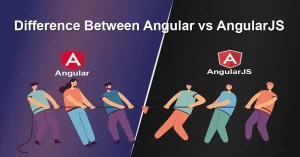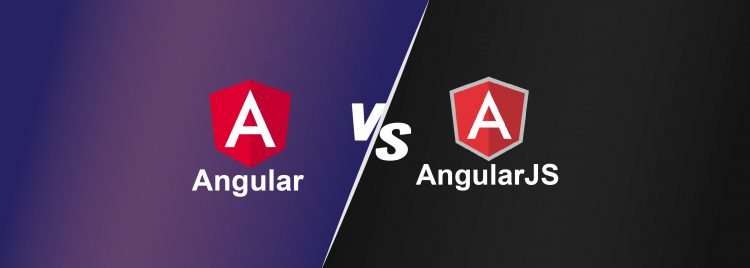Introduction to Angular vs AngularJS
Angular is probably a well-known framework for building online applications for the majority of front-end developers. If we want to use Angular in our project, we must pick between Angular vs AngularJS and other versions.
In 2009, AngularJS or, as some may prefer, Angular 1 was released. It enables two-way data binding and allows data changes in JavaScript to be automatically shown on the user interface. AngularJS also includes directives that enable us to write more isolated and reusable code than ever before. In general, it makes it easier for programmers to develop MVC or MVVM applications, also known as MVW architecture (Model-View-Whatever). Because of its dependency injection method, which helps mock dependencies, it took a step forward in testing front-end apps.
In today’s digital spaces, businesses are always looking for methods to differentiate themselves from their competitors. Web and mobile applications have become a must-have and efficient marketing tool for any successful organization. Frameworks are used to create user-friendly apps. Angular vs AngularJS is the most popular front-end web development framework among the greatest javascript frameworks. Let’s look at the approaches to see what the differences are between Angular vs AngularJS.
AngularJS in angular vs angularJS is a popular framework these days among Angular vs AngularJS since it allows for the creation of great single-page web apps. It’s a structural framework that effectively extends the HTML Document Object Model (DOM). With the additional capabilities and aids in the formation of a responsive application to the actions of the users. Angular versions, on the other hand, are a powerful front-end technology that provides components that let a developer produce and rewrite easy-to-use, legible, and manageable code.
What is Angular?

The majority of firms have already acknowledged that their online and mobile application development platforms are the core of their operations. Yes, we’re talking about the Angular framework, the most promising open-source front-end web application. Angular in angular vs angularJS, as one of the top names, has made a significant contribution to improving the efficiency and performance of all front-end applications. As a framework, Angular in angular vs angularJS provides out-of-the-box functionality, tools, and resources to assist you in developing quicker, scalable contemporary apps.
Angular in angular vs angularJS is a TypeScript-based open-source JavaScript framework. It’s operated by Google, and one of its main goals is to develop single-page apps. Angular in angular vs angularJS has evident advantages as a framework, and it also provides a common structure for developers to work with. It enables users to create large, easy-to-manage applications.
Angular in angular vs angularJS is a client-side open-source JavaScript-based front-end framework for creating customized HTML, CSS, and Typescript applications. Misko Hevery and Adam Abrons started AngularJS as a Google project in 2009. Because of its MVC (Model-View-Controller) functionality, it is a front-end JavaScript framework that was created to make developing web-based dynamic applications easier. Although AngularJS is no longer being developed or updated, it is still maintained as a framework.
Don’t mix it with Angular in angular vs angularJS (without JS), which refers to Angular 2 and higher (i.e. versions 2, 4, 5, 6, 7, 8, and currently 13, which was published in 2016). Angular 2, as it was formerly known, differed significantly from AngularJS, the most notable of which is a change in the template language.
The usage of TypeScript as a programming language is one of Angular’s primary features. Angular in angular vs angularJS apps may also be written in languages like Dart or JavaScript. However, TypeScript remains the major programming language.
There are 4 primary forms of web app development in Angular:
- PWAs (Progressive Web Apps)
- UI animations
- Web and mobile applications
- Business web applications
Need for Framework in Angular
Frameworks, in general, improve web development efficiency and performance by providing a uniform framework that eliminates the need for developers to rewrite code from the ground up. Frameworks are time-savers that provide developers with a slew of additional functionality that can be added to applications with minimal effort.
Angular in angular vs angularJS as a framework is best defined by this definition, which is among several accessible online. The technology or the framework that serves as a solid link between HTML and amazing web applications. Since its conception, Angular, a JavaScript open-source front-end web application framework, has been the subject of much discussion. Its godfather is Google, which has successfully maintained it and is on the verge of breaking new ground with Angular.
With the primary goal of developing single-page apps, Angular in angular vs angularJS includes capabilities such as model view controller, dependency injection, two-way binding, third-party libraries, third-party features, lazy user interface loading, and more to create/build dynamic, massive online and mobile applications.
Let’s get this party started! Let’s have a look at a few different Angular versions:
- AngularJS: In 2009, AngularJS was the most used version, and it was recognized for generating single-page apps for spas.
- Angular 2: Released in 2016, with Google’s assistance, Angular 2 included a number of enhancements to the original framework, including a transition to a component-based architecture.
- Angular 4: Angular 4 was released in 2017 and is backward compatible with previous versions. It has a new display engine and code generation optimizations.
- Angular 5: This version adds support for Progressive Web Apps, a build optimizer, and better material design, among other features. In 2017, this was also released.
- With Angular 6, web developers may concentrate on a toolset that simplifies the mitigation of all apps.
- The goal of Angular 7.0 is to improve app performance. This, however, is not the case. Virtual Scrolling, Improved Accessibility of Selects, and other graphic upgrades may be seen. Angular Material Design and the CDK include all of this information (Component Dev Kit).
- Bug fixes and router features were the major emphases of Angular 7.1. And the most recent version, Angular 7.2, was launched in 2018, two years after COVID-19 began. However, there is no stopping them; with unrivaled router capabilities, the underlying structure has been greatly improved.
Need For Angular
Client-side scripting languages like JavaScript are the most popular. It’s embedded in HTML documents to allow for a variety of unique interactions with websites. It’s well-suited to developing contemporary apps as a reasonably easy-to-learn language with widespread support. JavaScript, on the other hand, is the best language for creating single-page apps that demand modularity, testability, and developer productivity? Not likely. There are several frameworks and libraries available now that are aimed to give alternate
options. Angular in angular vs angularJS tackles many, if not all, of the challenges that developers have when utilizing JavaScript alone for front-end web development.
Why use Angular vs AngularJS?
Angular in angular vs angularJS is a popular framework for developing online and mobile apps, and it may be ideal for creating large-scale, powerful, and easy-to-use web applications. The following is a list of reasons why you should use Angular:
- Safety: Because it is maintained by Google, Angular is a pretty reliable platform.
- Development time is cut in half: By converting templates into code, Angular relies on the existing JavaScript virtual engine. The load time of Angular is also quick.
- Friendly to unit tests: Two-way data binding of modules and components is a feature of Angular that makes the code consistent and easy to comprehend for unit testing. Throughout the app development process, every unit of code is independently checked, ensuring thorough quality control.
- Cross-platform: PWAs built with Angular may operate on a broad range of devices, and the framework is extensively utilized in native mobile apps. Previously, frontend developers utilized an Ionic and Angular cross-platform combination. It’s most frequent pairing nowadays is with NativeScript.
- The learning curve is rather complicated: The learning curve for Angular is substantially harder than for other frameworks. To get started, you should look at all parts of the framework, not just fundamental JavaScript, such as RxJS (a reactive library for asynchronous programming) and Typescript (used to improve maintainability and code support capabilities).
- Community: Angular offers a wonderful community and environment that is well-supported. There is a lot of information on the framework, including instructions and videos, as well as a number of third-party tools.
With all of its benefits, Angular in angular vs angularJS isn’t a one-size-fits-all answer for every assignment, and that’s fine. Every technique is ideally adapted to solving certain problems, and other approaches will be better appropriate for other jobs. It’s simple to utilize Angular to develop a project, but it’s more difficult to determine whether this solution is truly useful or worthwhile.
Features of Angular vs AngularJS
- Two-way Data Binding: Angular has a two-way data binding functionality that guarantees flawless synchronization between the model and the UI. Once the model data has been corrected, you will notice a difference in the display. And the other way around. Both the model and the view will be updated in real-time as a result. Data binding is a web browser feature that allows users to alter web page components. It makes use of dynamic HTML and does not necessitate any scripting or programming. Data binding is a technique used in websites with interactive elements like calculators, tutorials, forums, and games. When a web page has a significant quantity of data, it also allows for a better incremental presentation.
The two-way binding is used by Angular. Any modifications made to the associated UI components are reflected in the model state. The UI state, on the other hand, represents any changes in the model state. The framework may use this functionality to connect the DOM to the model data via the controller.
- Dependency Injection: One such feature that deals with how a portion is Dependency Injection (DI). Components may easily obtain their dependencies here, but how this is accomplished is handled through dependency injection. It is now able to describe your programme declaratively, regardless of its type. If a component does not meet the demands of the user, it may be quickly changed via dependency injection.
- Document Object Model: The Document Object Model treats an XML or HTML document with many nodes as a tree that develops over time. Regular DOM is used by the angular framework. Angular will update the entire tree no matter how many times you edit the same HTML page.
- Typescript is another important aspect of the angular framework: This is a sort of Javascript that, as the name indicates, can run on any platform, and Angular is no exception. Although it is not required to utilize Typescript when developing Angular apps, it is recommended. It is, nevertheless, strongly recommended because it has a superior syntactic structure.
- Test: Angular allows developers to construct several types of test cases using the Jasmine testing framework. The Jasmine framework has a number of features that may be used to create various types of test scenarios. Karma is the test task-runner that uses a configuration file to configure the start-up, reporters, and testing framework.
Angular Architecture
Angular in angular vs angularJS is a model-view-controller (MVC) framework in its purest form. It gives explicit instructions on how to organize the application and supports bi-directional data flow with actual DOM.
Modules
An Angular app contains a root module called AppModule that offers the application’s bootstrap mechanism.
Components
- Each application component creates a class that contains the application logic and data.
- A component is a term that refers to a section of the user interface (UI).
Templates
The Angular template uses Angular markup in conjunction with HTML to alter HTML components before they are shown.
Data binding may be divided into two categories:
- Event binding allows your programme to update its data in response to user interaction in the target environment.
- Users can interpolate values computed from your application data into HTML using property binding.
Metadata
Angular in angular vs angularJS uses metadata to determine how to handle a class. It is used to decorate a class so that the anticipated behavior of the class may be configured.
Services
A service class is developed when you have data or logic that isn’t related to the view but has to be shared across components. The @Injectible decorator is always connected with the class.
Dependency Injection
- This functionality allows you to make your component classes as simple as possible.
- It doesn’t pull data from a server, check user input, or log to the terminal directly.
- Instead, it delegated these responsibilities to the services. Angular has a set of benefits and drawbacks of its own. They are briefly explained in the next parts of the blog.
What is Angular used for?

Angular is suitable for a wide range of online and mobile apps, but it is particularly well suited to certain software solutions. Angular may be used to make the following sorts of apps:
- Large Enterprise Apps: Angular in angular vs angularJS is commonly used to build large-scale systems that cater to the demands of businesses or organizations rather than individual users. These apps aid in the organization of company workflow and the management of specialized processes. CRMs, ERP systems, payment processing platforms, email marketing platforms, content management platforms, and so on are
examples of such systems. - Single-Page Applications (SPAs): Single Page Apps are dynamic applications. When a user navigates the software, it indicates that no page reloading happens. The data is received and returned normally, but the app does not need to load new pages from a server every time a user performs an action on the page.
- Progressive Web Applications (PWAs): An Angular in angular vs angularJS PWA is a low-cost solution that allows you to use web technologies to run mobile apps on both online and offline platforms. Browser-based apps that behave similarly to native programmes are known as Progressive Web Apps (PWAs). People love PWAs since they don’t have to download the app from Google Play or the App Store and can start using it straight away.
Advantages of Angular vs AngularJS
- Effective Cross-Platform Development:
The framework is frequently utilized in native-like mobile apps, in addition to delivering cost-effective Angular progressive web app solutions that can operate across mobile devices. Because Angular in angular vs angularJS is effective at emulating actual native apps, more firms are looking to create cross-platform solutions with it. For cross-platform development, front-end developers previously employed the Ionic Plus Angular combination. Angular Plus NativeScript is now the most common combination when angular vs angularJS.
A developer may construct a native-like UI by combining Angular with TypeScript features like services, dependency injection, and routing. NativeScript allows programmers to leverage native APIs. As a result, you’ll have a cross-platform app that works on both iOS and Android. Even yet, developing both online and mobile apps is a different endeavor. - High Quality of the Application: Because Angular in angular vs angularJS is a complicated and difficult-to-learn platform, it necessitates the credentials of a developer. Many structural pieces, such as injectors, components, directives, pipes, services, and so on, might be difficult for new developers to grasp. They are, nevertheless, a significant bonus for the product’s success because Angular has a rich set of built-in capabilities that allow you to develop everything you can imagine.
- Improved Speed and Performance: The variety of Angular in angular vs angularJS features, such as template syntax, Angular CLI, routers, and others, make programming easier and allow for faster application loading. To properly display obtained data in the UI, the framework is compatible with a variety of back-end programming languages.
- Faster Development Process: Because of the technological benefits provided by the Angular framework, a developer may build Angular in angular vs angularJS web apps quicker and more efficiently. The following is a list of factors that help programmers develop quicker using Angular.
- Angular in angular vs angularJS developers worked hard to make the framework friendly and simple to understand. They provided painstakingly written documentation, along with great code samples, so that a developer could quickly resolve any issues that developed during the development of an application.
- Because it provides a collection of useful coding tools, the Angular command-line interface makes the developer’s job simpler. Angular CLI may be enhanced with third-party libraries to handle odd and difficult software challenges, in addition to its robust built-in capabilities, which we’ll go over in more detail later.
- The time-saving aspect of two-way data binding is that it automates various code generation procedures. If a developer changes something in the model in an AngularJS Model-View-Controller architecture, the view matching that model changes as well, and vice versa. In a nutshell, when app data is changed, the user interface changes as well.
- The most recent versions of Angular in angular vs angularJS allow you to create two types of bundles: code-containing tools and resources for efficient development. To make the app browser-compatible, one bundle is utilized for current browsers that support ES2015+ and another for older browsers that support the ES5 JS version. Browsers may load less code and polyfills with differential loading, making the app more productive when compared in angular vs angularJS.
- Angular was built by Google to be used internally for official web pages and to solve difficulties in the company’s internal systems. Every six months, Angular releases a new version with minor modifications and a steady, but confident, the evolution of the framework.
- Readable and Testable Code: The structural aspects that make Angular code logical, consistent, and easy to comprehend for a front-end specialist are:
-
-
- Modules: The structure of the framework, which comprises modules, components, directives, pipelines, and services, is related to Angular modularity. Your application is suited for unit testing since the framework’s structure is organized into modules and components. Throughout the development process, each code unit is checked independently, allowing for careful quality control.
- Components: The classic MVVM (Model-View-ViewModel) and MVC (Model-View-Controller) architectures may be written using AngularJS, which improves code reusability. Because you can construct anything using a model-view pattern, the MVW (Model-View-Whatever) acronym was born out of the framework’s versatility. The most recent versions feature a component-based structure, which implies that all of the elements are self-contained.
-
- More Lightweight Web Applications: A common issue noted by the developer community in prior versions of the framework was too big to bundle size, which slowed the loading of apps. In subsequent versions of Angular in angular vs angularJS, the developers address this problem with the following enhancements:
- Modules with a Slow Load Time: Modules are logical divisions of business components. Lazy-load modules may be used in large Angular projects to show different app components depending on where the user is in the app. By lowering the size of the initially-loaded app, this functionality aids in the performance of such apps.
- Ivy Renderer: IT is a type of renderer that uses ivy to create a renderer is an engine that takes a developer’s instructions and converts them into DOM – a web page interface that allows you to control the content, structure, and styles of the page. To speed up the programme, the Ivy renderer permits smaller bundles.
- Efficient Problem-Solving Patterns: Angular in angular vs angularJS provides sophisticated DI (dependency injection) tools and services to help developers handle a variety of productivity difficulties and accelerate the development process:
- Dependency Injection: DI is a design pattern that allows you to increase an application’s modularity and efficiency. It’s a technique for making items that rely on other objects. Angular allows you to delegate some server-side services to the client-side component using dependency injection.
- Angular Services: Angular Services is a collection of Angular components. Angular components aren’t meant to capture and preserve data; instead, they’re meant to represent and provide services access to that data. Angular in angular vs angularJS Services make it easier to link business logic with app UI while also c
leaning up the code. - Excellent Material Design Library: Angular Material is a library that allows you to use Material Design features in your applications. Google created Material Design as a design foundation for creating highly responsive and productive user experiences. Programmers like Angular Material because it makes incorporating Angular design aspects in subsequent projects easier and faster after they’ve mastered it.
Limitations in Angular vs AngularJS
There are a few flaws in the Angular in angular vs angularJS development process. The framework, on the other hand, is continually evolving, and its community offers a variety of solutions to difficulties. Here’s a quick rundown of Angular’s drawbacks and how to solve them:
- Steep Learning Curve: Because Angular is more than simply a framework, it’s also a platform, it’s more difficult to master at first. Angular features a larger number of structures, such as Injectables, Components, Modules, and Directives, than other JS front-end frameworks like React or Vue.js, which takes more effort to grasp. Angular, on the other hand, is well worth the effort because it comes with a large number of built-in features that aid in the development of a successful programme.
- Applications of large size: If you choose the improper coding technique, your Angular app will be large (2 to 5 MB and above) and sluggish. To ensure that the application runs as quickly as possible, qualified professionals create the appropriate architecture for each situation and keep an eye on the bundle size. Other approaches to dealing with the problem of excessively big apps include employing lazy-load modules, the Ivy renderer, or other capabilities tailored to the app’s needs.
What is AngularJS?

AngularJS is a JavaScript MVC framework for creating client-side dynamic web applications. AngularJS started as a Google project but has now evolved into a free and open-source framework. There is no requirement to learn another language or syntax because AngularJS in angular vs angularJS is purely based on HTML and JavaScript. AngularJS is a framework that transforms static HTML into dynamic HTML. It improves HTML’s usefulness by including built-in attributes and components, as well as allowing users to create extra attributes using simple JavaScript.
AngularJS in angular vs angularJS is a framework for building dynamic web applications. It allows you to utilize HTML as your template language and enhance HTML’s syntax to represent the components of your application simply and succinctly. Data binding and dependency injection in AngularJS in angular vs angularJS remove a lot of the code you’d have to write otherwise. And because everything happens in the browser, it’s a great companion for any server technology.
It would have been AngularJS if HTML had been invented for applications. HTML is an effective declarative language for static texts. It does not have much in the way of application development, thus designing web apps is a game of guessing what I need to do to get the browser to do what I want.
Applications of AngularJS
Complete Package for Client-Side
AngularJS is not a standalone component in the client-side development of a web application. It takes care of all the DOM and AJAX glue code you used to write by yourself and organizes it into a logical framework. As a result, AngularJS in angular vs angularJS has strong opinions about how a CRUD (Create, Read, Update, and Delete) application should be constructed. While it has an opinion, it also makes an effort to ensure that it is only a beginning point that can be readily changed. AngularJS in angular vs angularJS includes the following features out of the box:
- Everything you’ll need to create a CRUD app in one place: Data binding, basic templating directives, form validation, routing, deep linking, reusable components, and dependency injection are just a few of the features available.
- Testability story: Unit testing, end-to-end testing, mocks, and test harnesses are all examples of testing techniques.
- As a starting point, seed the application with a directory layout and test scripts in angular vs angularJS.
AngularJS’s focal point
AngularJS in angular vs angularJS makes application development easier by offering the developer a higher degree of abstraction. It comes at an expense of flexibility, just like any other abstraction. To put it another way, AngularJS isn’t right for every app. The CRUD application was designed with AngularJS in mind. Fortunately, CRUD apps account for the vast majority of online applications. It’s also helpful to know when an app isn’t a good fit for AngularJS in order to learn what it’s excellent at.
Games and graphical user interface editors are two examples of apps that need a lot of DOM manipulation. These apps are not CRUD apps, and as a result, they are unlikely to be a suitable fit for AngularJS. In some circumstances, a library with a lower degree of abstraction, such as jQuery, may be preferable.
Why Uses of AngularJS?

AngularJS is based on the idea that declarative code is superior to imperative code for creating user interfaces and connecting subprograms, while imperative code is better for expressing business logic.
- Decoupling DOM manipulation from app functionality is a great concept. This significantly improves the code’s testability.
- It’s a fantastic concept to treat app testing as equally important as app development. The structure of the code has a significant impact on the testing complexity.
- Decoupling the client and server sides of an application is a fantastic concept. This permits concurrent development to take place while allowing both sides to be reused.
- It is extremely beneficial if the framework leads developers through the full process of developing an app, from UI design to business logic development to testing.
- Making ordinary activities easy and difficult tasks feasible is always a smart idea when angular vs angularJS.
AngularJS relieves you of the following annoyances:
- Registering callbacks: Callback registration clutters your code, making it difficult to discern the forest for the trees. It’s a good idea to get rid of typical boilerplate code like callbacks. It drastically decreases the amount of JavaScript coding required and makes it easy to understand what your programme performs.
- Manipulation of the HTML DOM programmatically: Manipulation of the HTML DOM programmatically is a key feature of AJAX applications, but it’s time-consuming and error-prone. You may avoid low-level DOM manipulation duties by declaratively expressing how the UI should update when your application state changes. Most AngularJS in angular vs angularJS apps don’t need to programmatically change the DOM, but you can if you want to.
- Assembling data to and from the UI: The bulk of AJAX apps’ duties are CRUD activities. There is a lot of boilerplate code in the flow of assembling data fr
om the server to an internal object to an HTML form, enabling users to amend the form, validating the form, displaying validation failures, returning to an internal model, and finally back to the server. AngularJS removes practically all of this boilerplate code, leaving just code that specifies the application’s basic flow rather than all of the implementation specifics. - Just to get started, you have to write a lot of startup code: To make a simple “Hello DataTrained” AJAX project to operate, you usually need to develop a lot of plumbing. You may simply bootstrap your project with AngularJS by employing services, which are auto-injected into your app in a Guice-like dependency-injection approach. This enables you to immediately begin building features. You also receive complete control over the startup procedure in automated tests as a bonus.
Advantages of AngularJS
- JavaScript MVC framework that is open source.
- Google Support.
- There’s no need to pick up a new scripting language. It’s just HTML and JavaScript.
- Using the MVC design pattern supports the separation of concerns.
- HTML is dynamic because of built-in attributes (directives).
- It’s simple to customize and extend.
- Single-page applications are supported.
- Dependency Injection is used.
- Easy to Unit test.
- REST friendly.
Difference Between Angular vs AngularJS

Let us look at angular vs angularJS differences in key features:
|
Key Features |
AngularJS |
Angular |
|
Architecture |
It is compatible with the Model-View-Controller architecture. The result is generated by the view, which processes the data in the model. |
It makes use of directives and components. Components are directives that are connected to a template. |
|
Written Language |
Written in JavaScript. |
Microsoft’s TypeScript language, which is a superset of ECMAScript 6 (ES6), was used to create this. |
|
Mobile support |
Mobile browsers are not supported. |
Angular is supported by all major mobile browsers. |
|
Expression Syntax |
The ng-bind library is used to connect data from the view to the model and likewise. |
The “()” and “[]” attributes are used to connect data between the view and the model. |
|
Dependency Injection |
Dependency Injection is not used. |
In Angular, a hierarchical DI mechanism is employed. |
|
Routing |
For routing configuration, AngularJS utilizes $routeprovider.when(). |
For routing configuration, Angular utilizes @Route Config(…) |
|
Structure |
Compared to Angular, it is more difficult to manage. |
It has a superior structure to AngularJS, making it easier to design and manage big applications, but it lags behind AngularJS when it comes to smaller apps. |
|
Speed |
Page load takes a long time since additional processing is done on the client-side. |
It has a superior structure and is quicker. |
|
SEO Support |
AngularJS does not give any real solutions for making the app search engine friendly when it comes to SEO. |
Angular provides the necessary pieces for search engines to quickly crawl web apps. |
|
CLI |
A CLI tool is not incorporated with AngularJS. |
The AngularCLI tool, which is included with the framework, allows you to build and manage components and other project files from the command line. |
|
Difficulty Level |
AngularJS is less difficult to understand and utilize than Angular. |
Due to the various rules that must be observed, learning Angular and applying it to front-end development is a demanding task. Building complete apps demand a thorough understanding of the Angular framework. |
|
Application Examples |
Lego, IStock, Netflix, and AngularJS official website. |
Gmail, JetBlue, Upwork, and Wikiwand. |
Conclusion to Angular vs AngularJS
For developing solutions of varying complexity, the Angular framework is the ideal option. Angular in angular vs angularjs will serve you well with front-end development chores, whether you need to create a web store, a tiny chat app, a news app, or an eCommerce site.
An Angular website can manage large amounts of traffic and deliver the necessary results. Furthermore, it is ideal for the creation of PWAs and SPAs. Angular also makes the app development process more manageable and will help you power your business with a customer-focused and simple-to-use app.
Frequently Asked Question’s
1. What is better Angular or AngularJS?
Both Angular vs AngularJS has their own set of advantages. Because Google maintains both frameworks flawlessly, it has widespread community support. The majority of users favor Angular because it creates single-page apps using HTML and TypeScript and makes dynamic apps for both mobile and web.
2. Why is AngularJS called Angular?
Because HTML uses angular brackets, and “ng” is short for “AngularJS.” Angular JS can be written inside HTML angle brackets, it is known as AngularJS. The inclusion of ‘ng’ in all of its directives is to indicate to the browser that this HTML page is using angularJS (Note the capital letters)
3. Why is Angular faster than AngularJS?
When Comparing Angular vs AngularJS, the Angular framework is comparable to other frameworks in terms of speed. In contrast Angular vs AngularJS, Angular may be up to 5 times quicker.
4. Which is latest Angular or AngularJS?
Angular vs AngularJS is a major version update to AngularJS and is an alternative to AngularJS. Angular 2.0 is the first release. When compared to AngularJS, it is really quick. It features a modular architecture, an angular CLI, and is simple to programme. The most recent stable version of Angular is 9.
5. Can I use jQuery with AngularJS?
Yes, AngularJS may utilize jQuery if it’s already installed in your project when it’s bootstrapped. If jQuery isn’t found in your script path, AngularJS uses its own version of the jQuery subset known as jQLite.
6. Is Angular compatible with AngularJS?
You can transclude content into Angular vs AngularJS components in the same way that you can project AngularJS content into Angular vs AngularJS components when utilizing updated versions of them.
7. What is AngularJS developer?
AngularJS developers are experienced JavaScript programmers that have a thorough understanding of theoretical angular software development. With Angular Java code, AngularJS engineers specialize in creating Single Page Applications (SPAs). They create everything that a user sees or hears on a website.
8. Is JavaScript necessary for AngularJS?
Before you begin using AngularJS, you must have a fundamental understanding of JavaScript. If you want to master basic AngularJS, you’ll need a thorough understanding of JavaScript.
Google’s Misko Hevery is a co-founder of AngularJS, a prominent JavaScript UI framework that has seen a lot of development recently.
10. What is AngularJS developer?
AngularJS developers are experienced JavaScript programmers that have a thorough understanding of theoretical angular software development. With Angular Java code, AngularJS engineers specialize in creating Single Page Applications (SPAs). They create everything that a user sees or hears on a website.













